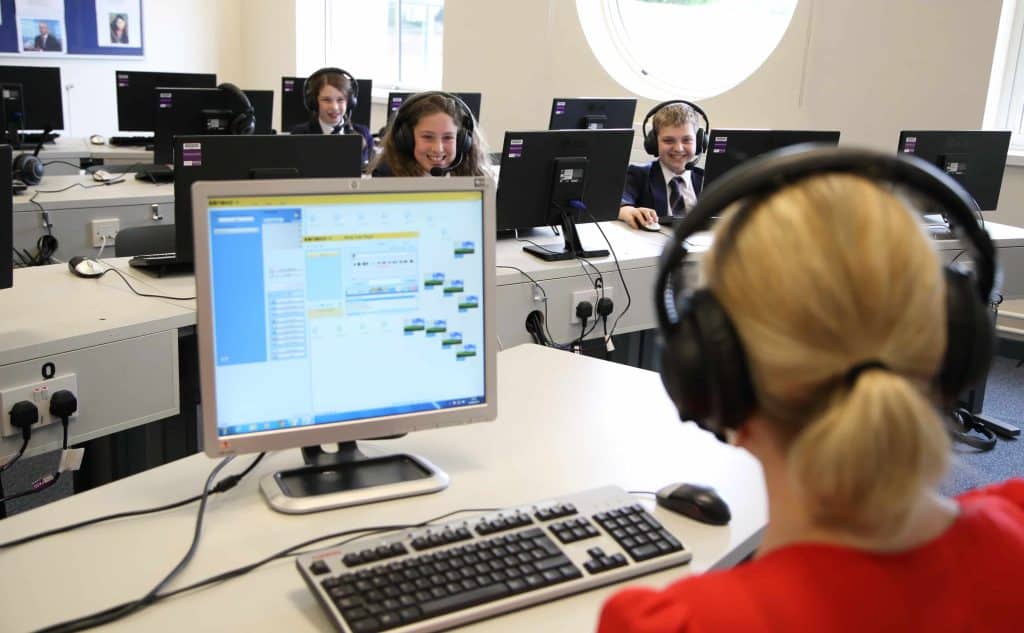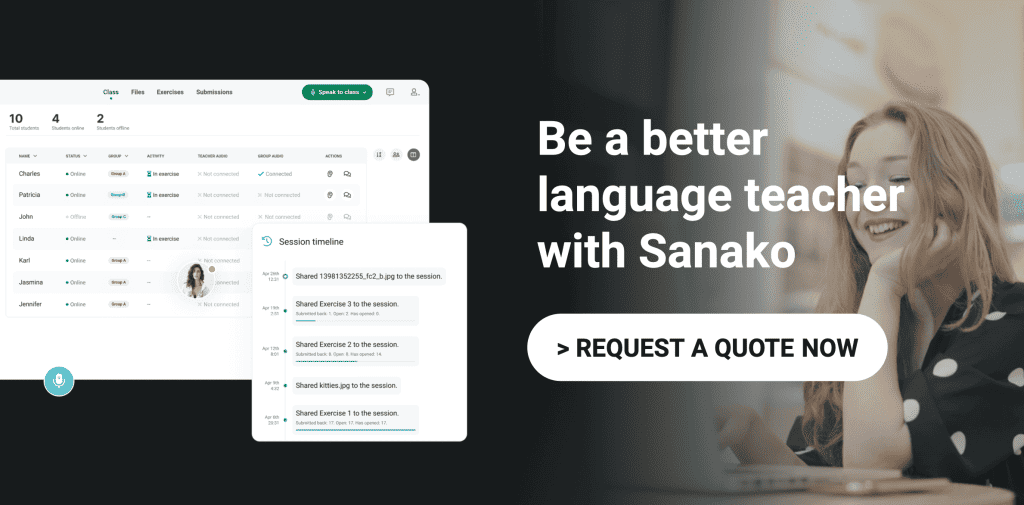The recent pace of change in education has been exceptional. That’s particularly true in language learning, which has seen huge upheaval as classes have been moved online. As a result, technology has also been quick to change and to impact traditional language labs. We’ve pulled together this list of FAQs to answer the commonly asked questions about language labs, digital language labs and more!
What is an English language lab?
The phrase ‘English Language Lab’ refers to the technology used by educational institutions to support students to learn English. Language labs usually involve a combination of hardware and software in a classroom and offer students a variety of ways to actively practice their core skills of listening, reading, speaking and writing.
Although there is no fixed model for what an English Language Lab should look like or include, they typically include the following elements.
- Teacher station – This might be a laptop or a desktop PC, but this phrase refers to the device used by the teacher to control and deliver language instruction. Each different language lab supplier uses a different software console to do this.
- Student station – Usually referring to the means by which students engage with their language learning resources, this is typically a special audio equipment or a normal desktop computer, laptop or tablet.
- Language lab headset – A good quality language learning headset is an essential element of an English language lab. It enables students to listen to English language content as well as allowing them to record their own voice in any speaking tasks.
- Server – This hosts the language lab software (see below) and brings together learner and educator. The server may be located at the individual institution or may also be hosted in the cloud.
Teacher and student positions are connected via a LAN (local area network) if they are using a desktop language lab software, like Sanako Study 1200, and via the Internet if they are using modern browser-based online language labs like Sanako Connect.
How does an English language lab differ from a foreign language lab?
The set-up and function of a foreign language lab is exactly the same as that for the English language lab as outlined above.
The combination of teacher and student station, headsets, server and language lab software is highly flexible and can be used to teach English or any other language. The term Foreign language lab is most commonly used in countries where English is the native language and where other international languages are therefore most commonly learnt.
How do digital language labs work?
As educational institutions need to offer more flexible ways to access learning, traditional physical language labs are now moving increasingly online. These digital language labs deliver all of the benefits and functionality of a physical language lab, but are accessible from anywhere using the internet and a web browser. Students can access learning at any time using their own devices, whilst teachers can lead classes remotely in real-time or leave lessons open for self-paced learning.
Sanako’s Connect product is a leading digital language lab for language teaching departments, high-schools and universities globally. It enables all students in a cohort to do speaking and conversation practice at the same time, and provides a powerful platform for educators to assess progress, create/share learning resources and provide feedback.
What learning activities can be delivered in a language lab?
The main purpose of a language lab is to actively involve students in language learning activities. In a language lab, all students are able to speak at the same time without distracting each other, regardless of the class size.
Some of the most common language lab activities are:
- pronunciation exercises
- model imitation (students listen to and repeat a model track to practice the stress, rhythm and intonation of a target language)
- listening comprehension
- reading practice
- vocabulary test
- live group and pair discussion
- role-plays
- examinations and oral language assessments.
Language labs therefore give students more opportunities to practice their core skills than is usually possible in a traditional classroom environment and makes the teaching time more efficient and effective. International research shows that in traditional classroom environments (without a language lab), with more than 10 students, each student gets less than one minute of speaking practice. Language labs can significantly increase this student speaking time (SST).
Language labs also:
- Enable teachers to easily integrate text, images, audio, video and other multimedia content into their teaching materials and share them with their students.
- Help students to record their own voice and play back the recordings as well as holding conversations with other students and educators.
- Support educators to control students’ computers and keep track of their progress.
- Allow students to independently access teaching materials.
How do I buy language lab software?
Language lab software refers to the technology that connects educators and students, enabling them to interact and learn a new language. This allows institutions to create databases of courses, classes and participants (educators and students) as well as libraries of teaching material. The software also enables students to capture/submit their own work and gives teachers the ability to comment and feedback on it.
Many providers offer different versions of their products with different configurations of language lab software. Sanako’s Study language lab software is, for example, available in three different formats, which are tailored to different school set-ups and requirements.
Institutions can also buy additional software that they need. Popular software modules for Sanako Study include pronunciation and conference interpreting modules. If you are interested in buying a language lab or language lab software for your school or educational institution, contact us by filling the language lab price request form on this page and we will help you forward.
What is the price of a language lab?
The exact price of a language lab depends on a number of key factors. The most important of which is whether the desired language lab solution will be hardware-based, desktop software-based or browser/cloud-based. Other factors which affect the price of a language lab are the length of the contract (e.g is an annual software licence, a multi-year contract, or perpetual license required?) and how many students/teachers does the language lab need to support?
Online browser-based language lab products like Sanako Connect come with an annual subscription and are at the lower end of the language lab price bracket. Such solutions can start as low as $10 – $20 per user per year (if the user amount is large and the institution chooses a longer contract period) and can be easily scaled up if more students/teachers need to access the platform. This also helps to mitigate risk and saves the school money. Sanako also offers a free trial period to schools and universities for testing our cloud-based language teaching solutions before making their purchase decision.
Mid-range solutions such as desktop software-based language labs with a perpetual license or high-end solutions (e.g a traditional hardware-based language lab installed in a dedicated classroom) can be much harder to price. The total cost will depend on the specific installation and whether teacher training, computer equipment and headsets are required. It’s essential for suppliers to fully understand the needs and requirements of every institution before providing a quote.
You can contact Sanako for a language lab price quotation by filling out the language lab price request form or sending as an email to info@sanako.com.
Who are the leading global providers of language labs?
Sanako is the global-leader and the original pioneer in language labs and language teaching software. Our business began already in 1961 under the name Tandberg Educational, so we are one of the most established and reliable language lab and language teaching software providers. Our sole focus is to help language teachers increase their students’ language skills. Over the last 60 years, we have grown to become global market leaders in teacher-led language teaching software and language labs with customers in 114 countries and +50,000 classrooms.
Working with an international network of over 100 dedicated partners and resellers, Sanako provides customers with a full range of language teaching and learning solutions. This includes everything from traditional classroom language labs to remote language teaching platforms.
What are the alternatives to language labs?
One of the biggest advantages of a modern software-based language lab is its extraordinary flexibility. A traditional physical language lab can only be established in a dedicated or temporary room in an educational institution. The major alternative to a physical language lab is a virtual one, which can be easily accessed online. Online language lab solutions such as Sanako Connect enable teaching and learning to be conducted remotely, with participants at a distance from their school, in addition to normal classroom face-to-face teaching. All of the individual functionality of the physical language lab is retained and enhanced for online learning use.
If you’d like to find out more about how Sanako’s suite of language teaching software and language labs can support your institutions language learning programs, please contact us now to request a price and learn more!

